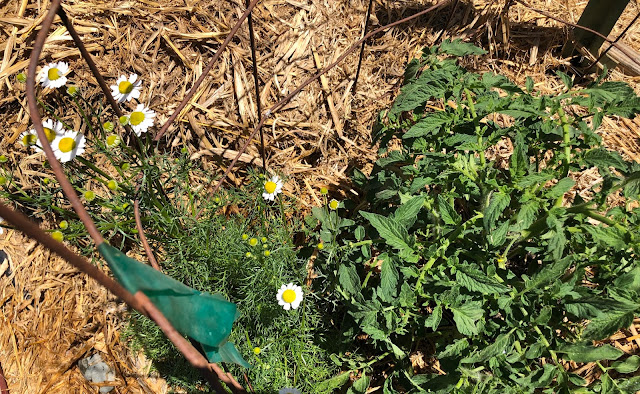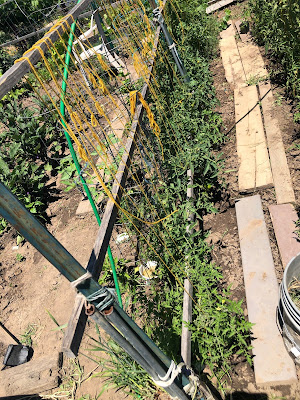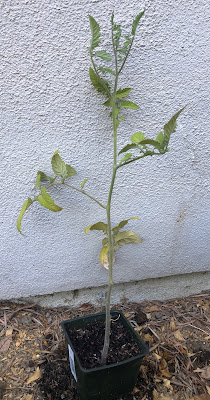
|
|
Breaking most of the failure rules here: The tomato plant is green and healthy, with support, straw mulch, and a companion chamomile plant to attract bees and
other pollinators. (Photos: Kathy Morrison)
|

|
|
This tomato row uses wooden stakes and strings to keep
the plants in line.
|
Just looking around the community garden where I have a plot, you can see so many different ways to grow tomatoes. Some people have them in ditches, some in raised beds. Fancy cages in one plot, contraptions of wire and twine and stakes in another. Some plants are pruned so much they look like bean poles; other tomato plants are so full and fluffy that you can't tell one plant from its neighbor.
You know what? We all manage to harvest tomatoes. So when it comes to growing Sacramento's favorite crop, I've decided that the only hard-and-fast rules are how NOT to grow tomatoes. If there's a link after the rule, it takes you to a good explanation of why this approach will fail:
1) Plant from seed, and leave the seedling indoors, with inadequate light, as long as possible. Result: Tall, lanky plant with a skinny stem.
See this guide, especially page 4
2) Alternatively, buy a tomato in a 4-inch pot, then keep it there for months. This also works with the seedling in #1.
3) Dig a very shallow hole. That is, when finally getting around to plant the 4-inch-contained, skinny, pathetic plant. Or put it in a very shallow pot, certainly no bigger than a 2-gallon container. Who needs roots?
Same link as above
, page 5.
4) Put those plants close together in the same place they grew last year. No amendments allowed.
Explained here
5) Cages, are you kidding? They're vines -- let them flop all over the bare ground. Farmers do it.
Back to this again, page 6
especially.
Also this
6) Water the plants when you feel like it. Five minutes one day, then 5 more next week. Or flood the area daily. Make them hew to your schedule. Oh, and no fertilizer, either.
Here's a classic.
7) Don't bother planting any flowers or herbs for pollinators. Why get the bees in on this?
Try this link
or
this one

|
Is this sad or what? Never planted,
never will be.
|
8) Pests are natural, so let them roam your tomatoes. Spider mites, tomato hornworms, whiteflies -- eh, just doing what comes naturally.
Try this
and scroll down to the pest section.
9) Blossom end rot? You know, those dark mush spots on the ends of the tomatoes (assuming your plant managed to produce any). Must be a calcium deficiency, so buy calcium tablets and put them in the soil.
http://farmerfred.com/blossomendrot.htm
10) Tomatoes like full sun. We live in "Sacratomato," after all, so that triple-digit summer heat shouldn't bother the tomato plants. Don't even think of using burlap or shade cloth over them to protect the fruit. Gotta love exploding tomatoes.
---------------------------------------------
So there it is, how to guarantee you won't get tomatoes.
I finally planted the last of my container tomatoes this week. Here's the official 2021 list:
The familiar:
Big Beef, Juliet, Jet Setter, First Prize, Lemon Boy -- all hybrids -- and Sweet Chelsea, a vigorous large cherry.
New for me:
Sungold Select -- a Wild Boar Farms variation on an old favorite; Chef’s Choice Red -- AAS winner; Brad’s Atomic Grape -- wild multicolored grape tomatoes, from Wild Boar Farms; Pink Boar -- pink and dark green, also WBF; Wine Jug -- dark purple, WBF; Tasty Pink -- a pink heirloom and incidentally a gorgeous plant; Orange Oxheart -- free seeds so why not; Lucid Gem -- Wild Boar Farms again, this one orange and yellow with purple skin.
In pots at home:
Patio Choice Yellow; Better Bush -- best container tomato I've found; Robeson -- overwintered survivor.
In grow bags, my big experiment this year:
Braveheart cherry; AAA Sweet Solano -- a Wild Boar Farms yellow-red; Cherokee Carbon -- wonderful hybrid of two heirlooms.
Here's hoping we all have a successful tomato-growing year, drought notwithstanding.


